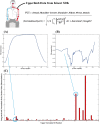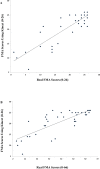Upper Extremity Functional Evaluation by Fugl-Meyer Assessment Scoring Using Depth-Sensing Camera in Hemiplegic Stroke Patients
- PMID: 27367518
- PMCID: PMC4930182
- DOI: 10.1371/journal.pone.0158640
Upper Extremity Functional Evaluation by Fugl-Meyer Assessment Scoring Using Depth-Sensing Camera in Hemiplegic Stroke Patients
Abstract
Virtual home-based rehabilitation is an emerging area in stroke rehabilitation. Functional assessment tools are essential to monitor recovery and provide current function-based rehabilitation. We developed the Fugl-Meyer Assessment (FMA) tool using Kinect (Microsoft, USA) and validated it for hemiplegic stroke patients. Forty-one patients with hemiplegic stroke were enrolled. Thirteen of 33 items were selected for upper extremity motor FMA. One occupational therapist assessed the motor FMA while recording upper extremity motion with Kinect. FMA score was calculated using principal component analysis and artificial neural network learning from the saved motion data. The degree of jerky motion was also transformed to jerky scores. Prediction accuracy for each of the 13 items and correlations between real FMA scores and scores using Kinect were analyzed. Prediction accuracies ranged from 65% to 87% in each item and exceeded 70% for 9 items. Correlations were high for the summed score for the 13 items between real FMA scores and scores obtained using Kinect (Pearson's correlation coefficient = 0.873, P<0.0001) and those between total upper extremity scores (66 in full score) and scores using Kinect (26 in full score) (Pearson's correlation coefficient = 0.799, P<0.0001). Log transformed jerky scores were significantly higher in the hemiplegic side (1.81 ± 0.76) compared to non-hemiplegic side (1.21 ± 0.43) and showed significant negative correlations with Brunnstrom stage (3 to 6; Spearman correlation coefficient = -0.387, P = 0.046). FMA using Kinect is a valid way to assess upper extremity function and can provide additional results for movement quality in stroke patients. This may be useful in the setting of unsupervised home-based rehabilitation.
Conflict of interest statement
Figures





References
-
- Nichols-Larsen DS, Clark P, Zeringue A, Greenspan A, Blanton S. Factors influencing stroke survivors’ quality of life during subacute recovery. Stroke. 2005;36:1480–4. - PubMed
MeSH terms
LinkOut - more resources
Full Text Sources
Other Literature Sources
Medical

